In the long journey of pursuing eternal youth, the scientific community has never ceased its exploration. In recent years, a natural compound called apigenin has come into view and become a research focus in the field of anti-aging. Apigenin, a flavonoid widely found in fruits and vegetables, has a unique chemical activity with hydroxyl groups precisely linked at the 4′, 5′, and 7′ positions, centered around a 2-phenylchromone. It is abundant in the stems and leaves of celery, giving this common vegetable special biological efficacy and being key to celery’s many health benefits.
Core Mechanism: How Apigenin Rewrites the Cellular Aging Process
(I) Targeting PRDX6 Protein: Blocking the Aging “Switch”
In the complex regulatory network of cellular aging, Apigenin acts like a precise “navigator,” locking onto a key target, peroxiredoxin 6 (PRDX6). As a key member of the peroxiredoxin family, PRDX6 performs multiple functions. Its phospholipase A2 (PLA2) activity plays a central role in cellular lipid metabolism, inflammatory signaling, and other processes. However, when cells face the threat of aging, abnormal activation of PRDX6 acts like a false “switch,” triggering a series of harmful reactions.
Using advanced biotin-labeled probe technology and drug affinity target stabilization (DARTS) technology, researchers clearly captured the direct binding of apigenin to PRDX6. This binding acts like a “shackle” on overactive PRDX6, specifically inhibiting its PLA2 activity. This inhibitory effect effectively blocks the activation of heat shock protein A8 (HSPA8), thereby disrupting its interaction with the ataxia telangiectasia mutated (ATM) protein and the p38 mitogen-activated protein kinase (p38MAPK) signaling pathway. This chain reaction successfully prevents the transition from the acute stress-associated phenotype (ASAP) to the senescence-associated secretory phenotype (SASP), fundamentally curbing the release of proinflammatory cytokines by senescent cells and effectively putting the brakes on cellular aging.
(II) Dual Regulation: Synergistic Antioxidant and Anti-Inflammatory Effects
Free Radical Scavenging: Free radicals, like “mobile bombs,” roam freely within cells, constantly threatening their health. Superoxide anions and hydroxyl radicals, among others, can attack key biomolecules within cells. For example, free radicals can break the double helix of DNA and damage its bases, leading to errors in genetic transmission. Mitochondria, the cell’s “energy factory,” are also susceptible to free radical damage, damaging their membranes and respiratory chain proteins, hindering energy production. Apigenin, with its unique molecular structure, acts like a “precise sniper rifle,” effectively neutralizing these free radicals. In vitro cell culture experiments revealed that treatment of cells with a certain concentration of apigenin significantly reduced intracellular reactive oxygen species (ROS) levels by 30%-50%, as measured by fluorescent probe technology. This strongly demonstrates apigenin’s powerful free radical scavenging ability, providing cells with a strong antioxidant defense.
Inhibiting the inflammatory cascade: Inflammation is like a civil war within the body, and chronic inflammation is a catalyst for accelerated aging. In the inflammatory signaling pathway, nuclear factor κB (NF-κB) acts like a “commander.” Once activated, it issues commands, prompting cells to secrete numerous pro-inflammatory factors, such as interleukin-6 (IL-6) and tumor necrosis factor α (TNF-α). These factors trigger a chain reaction of inflammation, leading to tissue fibrosis and organ dysfunction. Apigenin cleverly intervenes by inhibiting the activation of the NF-κB pathway, effectively silencing the “commander,” reducing the secretion of pro-inflammatory factors. In animal experiments, feeding apigenin to mice with inflammation significantly reduced IL-6 and TNF-α levels in their serum and tissues, significantly alleviating inflammatory symptoms. This demonstrates apigenin’s remarkable efficacy in inhibiting the inflammatory cascade and creating a favorable internal environment for delaying aging.
(III) Remodeling the Senescent Cell Microenvironment
Senescent cells not only decline in their own function but also negatively impact the surrounding cellular microenvironment, much like a small rat dropping spoiling the whole barrel. The SASP they secrete contains multiple matrix metalloproteinases (MMPs). These enzymes act like “scissors,” destroying the collagen and elastic fiber networks within the extracellular matrix (ECM), leading to skin sagging, wrinkles, and decreased organ and tissue structural stability.
Apigenin, a unique “senomorphic agent,” takes an unconventional approach. Rather than directly eradicating senescent cells, it employs a gentler and more subtle approach—modulating their secretory function. Studies have shown that apigenin can inhibit the activity of SASP-associated MMPs, acting like a protective sheath for the scissors, reducing damage to the ECM and maintaining the structural integrity and stability of skin and organ tissues. In a skin cell model, apigenin-treated senescent cells secreted less MMPs, inhibited the degradation of collagen and elastic fibers, and maintained the ECM structure, providing strong support for skin firmness and elasticity. This demonstrates apigenin’s anti-aging potential at the cellular microenvironmental level.
Multi-system Anti-Aging Effects: Rejuvenating Interventions from Molecular to Organismic Perspectives
(I) Skin Anti-Aging: Protecting the “Scaffolding of Youth”
Skin, the largest organ in the human body, is the most visible manifestation of aging. With the passage of time, the collagen and elastic fibers in the skin gradually decrease, much like the scaffolding of a building slowly corroding and weakening, leading to sagging skin and wrinkles. Apigenin demonstrates remarkable efficacy in skin anti-aging, safeguarding skin’s youthful appearance.
When it comes to collagen protection, ultraviolet light is considered the skin’s number one killer. It activates collagenases such as matrix metalloproteinase-1 (MMP-1). These enzymes act like scissors, ruthlessly severing collagen fibers and causing the skin to lose elasticity. Apigenin acts as a loyal guardian, inhibiting this destructive behavior by downregulating the activity of collagenases like MMP-1. In in vitro experiments, researchers applied apigenin to UV-damaged skin fibroblasts and surprisingly found that collagen synthesis increased by 20%-30%. Previously broken collagen fibers were effectively repaired, laying a solid foundation for skin firmness and elasticity.
The integrity of the skin barrier is crucial for maintaining skin health. It acts like an invisible protective film, preventing water loss and shielding against the invasion of harmful substances. With aging, the skin barrier function gradually weakens, keratinocyte proliferation decreases, and ceramide production decreases, leading to dryness and roughness of the skin. Apigenin cleverly addresses these issues by promoting keratinocyte proliferation and accelerating skin metabolism, injecting a “vitalizing force” into the skin. Furthermore, apigenin upregulates the activity of enzymes involved in ceramide synthesis, increasing ceramide synthesis and enhancing the skin’s water retention capacity. In animal studies, apigenin administration to aged mice significantly increased the moisture content of their skin, significantly improving dryness and roughness. The skin barrier function was effectively repaired, leaving the skin with a hydrated and radiant appearance.
(II) Organ Rejuvenation: Delaying Functional Decline
Cardiovascular Protection: The cardiovascular system is like the “river of life” in the human body. With aging, this “river” gradually develops problems, leading to diseases such as dyslipidemia and atherosclerosis, which pose a serious threat to life and health. Apigenin brings new vitality and vigor to the cardiovascular system. Regarding blood lipid regulation, apigenin inhibits the activity of fatty acid synthase (FAS), reducing fatty acid synthesis, essentially pausing the fatty acid synthesis “production line.” It also regulates the activity of lipoprotein lipase (LPL) and hepatic lipase (HL), promoting triglyceride catabolism. In animal experiments, feeding apigenin to mice with high-fat diet-induced obesity significantly reduced serum levels of total cholesterol, triglycerides, and low-density lipoprotein cholesterol (LDL-C), while increasing high-density lipoprotein cholesterol (HDL-C), significantly improving blood lipid profiles. Endothelial cells, the guardians of the vascular lining, are directly linked to cardiovascular health. Endothelial dysfunction is an early sign of atherosclerosis, leading to abnormal vasoconstriction and dilation, inflammatory cell adhesion, and other problems. Apigenin protects endothelial cells through its antioxidant and anti-inflammatory properties, promoting the synthesis and release of nitric oxide (NO). NO is a key vasodilator that dilates blood vessels, lowers blood pressure, and inhibits platelet aggregation and thrombosis. Studies have shown that apigenin-treated endothelial cells increase NO release and enhance endothelial nitric oxide synthase (eNOS) activity, effectively improving endothelial function and reducing the risk of atherosclerotic plaque formation, providing a strong defense for cardiovascular health.
Neurocognitive Improvement: The brain, the “headquarters” of the human body, gradually becomes damaged with aging, leading to neurotransmitter imbalances and increased inflammatory responses. These damage lead to memory loss, cognitive impairment, and the development of neurodegenerative diseases such as Alzheimer’s disease. Apigenin has shown great potential in neuroprotection, offering hope for slowing brain aging. In animal experiments, researchers fed apigenin to aged mice. Through behavioral tests such as the Morris water maze and Y-maze, they found that the mice’s learning and memory abilities significantly improved. They were able to find hidden platforms more quickly and entered new arms in the Y-maze significantly more frequently, indicating improved memory and spatial cognition.
In-depth investigations into its mechanisms revealed that apigenin can alleviate inflammatory responses in the brains of aged mice and inhibit the expression of neuroinflammatory factors such as interleukin-1β (IL-1β) and tumor necrosis factor α (TNF-α), effectively cooling the brain’s “inflammatory storm.” Furthermore, apigenin protects the structural and functional integrity of synapses, promotes the synthesis and release of neurotransmitters, and enhances signaling between neurons. Furthermore, apigenin has an inhibitory effect on the pathological processes associated with Alzheimer’s disease. It can reduce the deposition of β-amyloid protein (Aβ) and inhibit the hyperphosphorylation of tau protein. These two pathological changes are core features of Alzheimer’s disease. Apigenin intervention effectively slows the progression of Alzheimer’s disease, allowing the brain’s “command center” to function efficiently for a longer period of time.
(III) Metabolic and Immune Regulation
Improving Glucose and Lipid Metabolism: The metabolic system is the body’s “energy factory.” With aging, metabolic function gradually deteriorates, and abnormal glucose and lipid metabolism becomes a health problem for many people, leading to diseases such as obesity and diabetes. Apigenin plays a positive role in regulating glucose and lipid metabolism, providing strong support for the normal operation of this “energy factory.” Regarding energy metabolism, apigenin can activate the adenosine monophosphate-activated protein kinase (AMPK) signaling pathway. AMPK acts like an intracellular “energy sensor.” When cellular energy levels decrease, AMPK is activated. It regulates a series of metabolic enzymes and proteins, promoting fatty acid oxidation, inhibiting fat synthesis, and increasing glucose uptake and utilization. Studies have found that cells treated with apigenin show increased AMPK phosphorylation, upregulated expression of genes related to fatty acid oxidation, and downregulated expression of genes related to fat synthesis. This significantly reduces intracellular fat accumulation and enhances energy metabolism.
Insulin resistance is a key pathogenesis of type 2 diabetes, leading to a weakening of insulin’s glucose-lowering effect and elevated blood sugar. Apigenin improves insulin resistance and enhances insulin sensitivity through multiple pathways. Firstly, apigenin can modulate the insulin signaling pathway, increasing insulin receptor substrate-1 (IRS-1) phosphorylation and promoting downstream phosphatidylinositol 3-kinase (PI3K)/protein kinase B (Akt) signaling, thereby enhancing cellular glucose uptake and utilization. Secondly, apigenin can also reduce the levels of inflammatory factors, mitigating the interference of inflammation on the insulin signaling pathway. In animal experiments, feeding apigenin to diabetic mice significantly reduced their blood sugar levels, increased insulin sensitivity, and improved glucose tolerance, effectively alleviating diabetic symptoms and ensuring more efficient energy distribution within the “energy factory.”
Enhanced Immune Surveillance: The immune system, the body’s defense force, gradually declines with aging, leading to the accumulation of senescent cells. These cells, like hidden enemies, evade immune clearance and secrete various cytokines, contributing to the formation of an inflammatory microenvironment, further accelerating aging and disease. Apigenin plays a unique role in enhancing immune surveillance, helping the immune system better identify and eliminate senescent cells.
Research has shown that apigenin can inhibit the mechanisms by which senescent cells evade immune clearance, maintaining the immune system’s ability to recognize and eliminate abnormal cells. It can modulate immune cell function, enhancing the cytotoxic activity of natural killer cells (NK cells) and cytotoxic T lymphocytes (CTLs) against senescent cells. Furthermore, apigenin modulates the immune microenvironment, reducing the secretion of immunosuppressive factors by senescent cells and increasing the expression of immune-activating factors. In in vitro experiments, apigenin was co-cultured with senescent cells and immune cells. It was found that the killing effect of immune cells on senescent cells was significantly enhanced, the number of senescent cells was reduced, and the “fighting power” of the immune system was effectively maintained, keeping the body’s “defense force” vigilant at all times to resist the invasion of aging and disease.
 Application Prospects: From Dietary Supplements to Precision Anti-Aging Therapies
Application Prospects: From Dietary Supplements to Precision Anti-Aging Therapies
(I) Daily Anti-Aging: Dietary Intake and Functional Foods
In daily life, celery, chamomile, and citrus fruits are all excellent natural sources of apigenin. Every 100 grams of celery contains 10-20 mg of apigenin. Regular consumption of celery, whether stir-fried, in salads, or juiced, ensures a certain amount of apigenin intake. Chamomile, besides being used in teas, is also used in some high-end skincare and aromatherapy products, allowing people to enjoy relaxation while benefiting from the antioxidant and anti-inflammatory effects of its apigenin.
In the future, as people’s focus on health continues to increase, fortified foods and dietary supplements are expected to become convenient ways to ingest apigenin. Adding apigenin to everyday foods such as bread and yogurt allows people to easily ingest this beneficial component while enjoying delicious food. Dietary supplements, on the other hand, can precisely control the dosage of apigenin according to the needs of different groups, offering convenience and speed. To further enhance its anti-aging effects, apigenin can be combined with ingredients such as vitamin C and resveratrol. Vitamin C’s powerful antioxidant capacity works synergistically with apigenin to enhance free radical scavenging; resveratrol also has antioxidant, anti-inflammatory, and cell metabolism-regulating effects, and together with apigenin, it can delay the aging process from multiple dimensions.
(II) Potential in the Pharmaceutical and Aesthetic Medicine Fields
Disease Intervention: Age-related diseases such as atherosclerosis and osteoarthritis seriously affect people’s quality of life and health. Apigenin, with its unique mechanism of action, shows great potential in the development of targeted drugs for these diseases. In the prevention and treatment of atherosclerosis, apigenin, through its multiple effects such as regulating blood lipids, inhibiting inflammatory responses, and protecting vascular endothelial cells, is expected to become a novel anti-atherosclerotic drug. Preclinical studies have shown that apigenin can significantly reduce cholesterol and triglyceride levels in the blood of experimental animals, reduce lipid deposition on the blood vessel walls, and effectively delay the formation of atherosclerotic plaques. Osteoarthritis is a common degenerative joint disease, and its pathogenesis is closely related to the degradation of articular cartilage and inflammatory responses. Apigenin can inhibit the destruction of articular cartilage by matrix metalloproteinases, reduce inflammation, and promote the proliferation and repair of chondrocytes. Studies have found that apigenin can upregulate the expression of type II collagen and proteoglycans in chondrocytes, enhancing the structural stability of cartilage and providing new insights for the treatment of osteoarthritis. Furthermore, combining apigenin with senolytics can more effectively eliminate senescent cells in the body, further enhancing the therapeutic effect on age-related diseases.
Medical Aesthetics Applications: In the medical aesthetics field, apigenin is also highly favored. Its derivatives have been used in skincare products. Through transdermal absorption, apigenin can penetrate deep into the skin to exert antioxidant and anti-inflammatory effects, effectively improving skin aging problems such as wrinkles and sagging. In a clinical study, after using skincare products containing apigenin derivatives for 8 weeks, the average wrinkle depth of the subjects’ skin decreased by 15%-20%, and skin firmness and elasticity were significantly improved. Apigenin can also regulate the dermal microenvironment, promote the synthesis of collagen and elastin fibers, inhibit the activity of matrix metalloproteinases, and reduce the degradation of the extracellular matrix. This series of effects comprehensively improves the structure and function of the skin, achieving skin rejuvenation from the inside out. From basic moisturizing lotions to high-end serums, more and more skincare products are incorporating apigenin into their formulas, bringing consumers a more efficient anti-aging skincare experience.
(III) Future Research Directions
In the future, research on apigenin will move towards a deeper and more precise direction. In exploring the interaction between apigenin and gut microbiota, researchers will delve into how apigenin regulates the composition and function of gut microbiota, and how changes in gut microbiota affect the metabolism and bioavailability of apigenin. Through this research, it is hoped that a apigenin-enhancing strategy based on gut microbiota regulation can be developed to further improve its anti-aging effects. Optimizing targeted delivery systems is also one of the research focuses. Currently, while nanotechnology and other methods exist to enhance the bioavailability of apigenin, achieving precise targeted delivery within the body to efficiently act on specific tissues and cells remains a challenge requiring further exploration. Developing novel carrier materials and delivery technologies to precisely deliver apigenin to sites of senescent cell aggregation and improve tissue specificity is a crucial goal for future research. Long-term safety assessments are equally essential. Although current research indicates that apigenin has good safety profiles, long-term, large-scale safety evaluations are vital as its applications expand. Studies involving different populations, dosages, and durations of use will provide a comprehensive understanding of the safety and potential adverse reactions of apigenin, offering a solid safety guarantee for its widespread application. Breakthroughs in these research directions will propel apigenin from a natural ingredient into a precise anti-aging agent, bringing greater benefits to human health and anti-aging efforts.
 Apigenin Ushers in a New Paradigm for Natural Anti-Aging
Apigenin Ushers in a New Paradigm for Natural Anti-Aging
Apigenin, a flavonoid naturally found in fruits and vegetables, has demonstrated immense potential in the anti-aging field due to its unique anti-aging mechanism and positive effects on multiple systems. From precisely targeting the PRDX6 protein to block aging signaling pathways, to its dual regulation of antioxidation and anti-inflammation, and its ability to reshape the microenvironment of aging cells, apigenin provides comprehensive care for youthful cells. It plays a vital role at multiple levels, including the skin, organs, metabolism, and immune system, improving various age-related physiological changes. From laboratory research to preclinical validation, the safety and efficacy of apigenin have been fully demonstrated, laying a solid foundation for its further application. Whether through natural intake in daily diets or application development in functional foods, pharmaceuticals, and medical aesthetics, apigenin shows broad prospects. In the future, with continued research, apigenin is expected to become a shining star in the field of anti-aging, contributing more to the beautiful vision of healthy aging for humanity.




















 Application Prospects: From Dietary Supplements to Precision Anti-Aging Therapies
Application Prospects: From Dietary Supplements to Precision Anti-Aging Therapies Apigenin Ushers in a New Paradigm for Natural Anti-Aging
Apigenin Ushers in a New Paradigm for Natural Anti-Aging